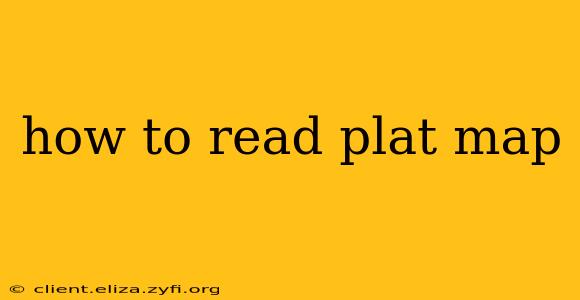Plat maps are essential documents for anyone involved in real estate, land surveying, or property research. Understanding how to read them is crucial for navigating property lines, identifying easements, and making informed decisions. This guide provides a comprehensive explanation of how to decipher the information contained within a plat map.
What is a Plat Map?
A plat map, also known as a plat of survey, is a detailed, scaled drawing showing the boundaries and divisions of a piece of land. It’s typically created by a surveyor and officially recorded with the local government. Plat maps are used to subdivide larger parcels of land into smaller lots, often for residential, commercial, or industrial development. They provide a visual representation of property lines, easements, rights-of-way, and other important features.
Key Elements of a Plat Map: Understanding the Symbols and Information
Plat maps use a variety of symbols and notations to convey complex information concisely. Understanding these elements is key to effective interpretation.
1. Property Lines and Boundaries:
These are usually depicted as solid lines, clearly defining the perimeter of each individual lot. Pay close attention to the angles and lengths – these are crucial for determining the exact size and shape of the property.
2. Lot Numbers:
Each individual lot is assigned a unique number, clearly indicated on the map. This number is essential for identifying specific properties.
3. Block Numbers:
Larger subdivisions are often divided into blocks, each containing multiple lots. Block numbers help organize and locate specific lots within the larger subdivision.
4. Streets and Roads:
Roads and streets are clearly shown, along with their names and widths. This is important for understanding access and location relative to other properties.
5. Easements:
Easements are rights granted to one party to use another's land for a specific purpose, like utility lines or access roads. These are usually indicated by hatched lines or specific symbols. Understanding easements is critical, as they can impact property usage and value.
6. Rights-of-Way:
Similar to easements, rights-of-way grant access to a specific area. These are typically shown as designated areas along roads or other boundaries.
7. Legal Descriptions:
Plat maps often include a legal description of the property, providing its precise location using metes and bounds or other surveying methods. This legal description is crucial for confirming ownership and resolving any boundary disputes.
8. Scale:
The map will usually indicate a scale, which shows the ratio between the map's dimensions and the actual dimensions of the land. This is essential for accurate measurements.
9. North Arrow:
A north arrow indicates the orientation of the map, allowing you to understand the relationship between properties and their surroundings.
10. Legend:
A legend (or key) explains the symbols used on the map. This is crucial for understanding all the notations used.
How to Effectively Read and Interpret a Plat Map
- Start with the Legend: Understand the symbols used before attempting to interpret the map.
- Identify the Scale: This is essential for accurate measurements.
- Locate the Property of Interest: Find the lot number or legal description corresponding to the property you are investigating.
- Trace the Property Boundaries: Carefully examine the lines defining the property's perimeter.
- Identify Adjacent Properties: Observe the properties surrounding the one you're focusing on.
- Note Easements and Rights-of-Way: Understand any restrictions or access rights affecting the property.
- Refer to the Legal Description: Verify the information on the map with the written legal description.
Frequently Asked Questions (PAA)
Where can I find plat maps?
Plat maps are typically available at the county recorder's office, surveyor's office, or the local municipality's planning department. Many counties also have online databases where you can access these maps digitally.
What is the difference between a plat map and a survey?
A plat map is a simplified representation of a land survey, showing property lines and other key features. A survey, on the other hand, is a more detailed and precise measurement of the land, often used to create the plat map.
Can I use a plat map to determine property value?
While a plat map can provide information about the property's size and location, which can indirectly influence value, it doesn't directly determine the property's market value. For a property valuation, you need a professional appraisal.
What if there are discrepancies in the plat map?
If you notice discrepancies or inconsistencies in the plat map, it's recommended to consult a professional surveyor or real estate attorney.
By understanding the key elements and utilizing these tips, you can successfully navigate plat maps and gain valuable insights into property boundaries, ownership, and other crucial information. Remember, while this guide provides a comprehensive overview, always consult with professionals for legal advice or complex property-related questions.
